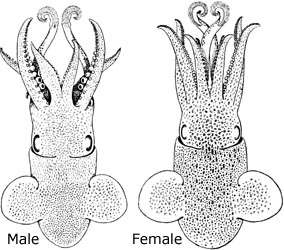Sepietta
Giambattista Bello, Michael Vecchione, and Richard E. Young- Sepietta neglecta
- Sepietta obscura
- Sepietta oweniana
Introduction
Diagnosis
A sepiolin ...
- without visceral photophores.
- with 12-32 suckers maximum in a transverse row on club.
Characteristics
- Arms
- Arm suckers in two series.
- Hectocotylus with 3-4 basal suckers followed by a copulatory apparatus with 4 modified stalks fused at their base to form a transverse crest, the lateral-most stalk hook-shaped; distally arm with spoon-like widening.
- Arm suckers in two series.
- Tentacles
- Tentacular club with suckers in 12-32 series.
- Tentacular club with suckers in 12-32 series.
- Photophores
- Photophores absent.
- Photophores absent.
- Gladius
- Gladius weakly developed ("... a very delicate, colorless thread ... which is difficult to find." Naef, 1923.)
- Gladius weakly developed ("... a very delicate, colorless thread ... which is difficult to find." Naef, 1923.)
- Female bursa copulatrix
- Bursa copulatrix roughly ear-shaped, devoid of cover.
Discussion of Phylogenetic Relationships
Sepietta oweniana and S. neglecta are considered sister species (Bello, 1998).Distribution
Eastern Atlantic Ocean from the Barents Sea to Mauritania and the Mediterranean Sea. They are found at depths from a few to more than 1,000 m (Bello, 2019).
References
Bello, G. 1998. Cladistic analysis of the Atlanto-Mediterranean sepiolines (Cephalopoda: Sepiolidae) based on morphological characters. Memorie del Museo Civico di Storia Naturale di Verona (2a ser.). Sezione Scienze della Vita, 13: 81-85.
Bello, G. 2019. The Mediterranean Sepiolidae (Mollusca Cephalopoda) diversity. Biodiversity Journal, 10: 389-404.
Naef, A. 1923. Die Cephalopoden. Fauna und Flora des Golfes von Neapel, 35(1, 1): 1-863.
About This Page

National Museum of Natural History, Washington, D. C. , USA

University of Hawaii, Honolulu, HI, USA
Correspondence regarding this page should be directed to Giambattista Bello at
Page copyright © 2020 , , and
 Page: Tree of Life
Sepietta .
Authored by
Giambattista Bello, Michael Vecchione, and Richard E. Young.
The TEXT of this page is licensed under the
Creative Commons Attribution-NonCommercial License - Version 3.0. Note that images and other media
featured on this page are each governed by their own license, and they may or may not be available
for reuse. Click on an image or a media link to access the media data window, which provides the
relevant licensing information. For the general terms and conditions of ToL material reuse and
redistribution, please see the Tree of Life Copyright
Policies.
Page: Tree of Life
Sepietta .
Authored by
Giambattista Bello, Michael Vecchione, and Richard E. Young.
The TEXT of this page is licensed under the
Creative Commons Attribution-NonCommercial License - Version 3.0. Note that images and other media
featured on this page are each governed by their own license, and they may or may not be available
for reuse. Click on an image or a media link to access the media data window, which provides the
relevant licensing information. For the general terms and conditions of ToL material reuse and
redistribution, please see the Tree of Life Copyright
Policies.
- First online 03 September 2004
- Content changed 31 March 2020
Citing this page:
Bello, Giambattista, Michael Vecchione, and Richard E. Young. 2020. Sepietta . Version 31 March 2020 (under construction). http://tolweb.org/Sepietta/20041/2020.03.31 in The Tree of Life Web Project, http://tolweb.org/










 Go to quick links
Go to quick search
Go to navigation for this section of the ToL site
Go to detailed links for the ToL site
Go to quick links
Go to quick search
Go to navigation for this section of the ToL site
Go to detailed links for the ToL site